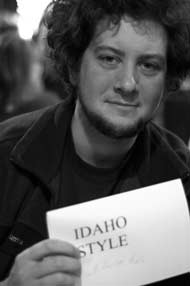
Portland resident Bjorn Warloe wants Oregon to take a cue from Idaho when it comes to how bicycles treat stop signs and traffic lights.
Since I met him last December, he has garnered interest and support from the Bicycle Transportation Alliance and some lawmakers in Salem.
I asked him a few questions about his effort:
Your group is called “Idaho Style”. Where does that name come from?
Idaho Style is a slogan that we hoped would be catchy while exemplifying what our group is trying to accomplish. It captures that the laws have been successfully implemented for years in Idaho. Also Oregon, and by extension Portland has been a state that really likes to lead on Bike and Pedestrian issues, the slogan is meant to push a button a little. If Idaho can handle this, can’t Oregon?
Why have you taken up this effort? Isn’t this something the BTA should be taking on?
We are working with the BTA, along with other bike groups. Every organization has to select their top priorities but it was an idea that didn’t make their list this year. Idaho Style is a group of people who wanted to make passing this legislation their top goal for the session.
“It was convenient for lawmakers to just classify bicycles as a vehicle, but clearly there are big differences between a semi truck and a bike.”
–Bjorn Warloe
How has the support/response been from the community and from legislators?
Once people understand what we are really trying to accomplish the response has been mostly positive. The negative responses I have heard are usually from people who envision it being legal to ride your bike through a stop sign at 25 mph, or to run a stop light during busy traffic. This isn’t what we are advocating at all, and once people understand that the idea of the law is to allow cyclists to carefully yield at a stop sign, or proceed through a deserted stoplight at night after coming to a complete stop they usually get behind the idea.
Why should bicyclists be given special legal consideration in this situation?
I think it is a mistake for bicycles and cars to be subject to all the same laws in all the same ways. It was convenient for lawmakers to just classify bicycles as a vehicle, but clearly there are big differences between a semi truck and a bike. In some ways this has already been recognized, no bicycle operators license/fee, lanes for bikes only, non motorized bike/pedestrian paths, these law changes represent an extension of that.
The BTA is working toward vulnerable user legislation (info, PDF) that recognizes that ped/bikes are less protected in the road, we are working on legislation that recognizes that ped/bikes are less dangerous, and less likely to cause injury to others.
Can you summarize the law in Idaho?
In Idaho the law allows a bicyclist to slow down before a stop sign and then make the decision to continue through if there is no traffic, or to stop if another bicyclist or vehicle has the right of way. The stop sign law has been in place for over 20 years and has been shown to work very well.
A few years ago they also passed a law allowing for bicyclists who are stopped at a red light to go ahead and go through if there are no cars coming. Mark McNeese, Idaho’s State Bicycle and Pedestrian Coordinator has told us that while the stop light law hasn’t really been around long enough to be sure of its effect its implementation went relatively smoothly.
What are some of the key hurdles you see in making this concept a reality in Oregon?
The biggest hurdle will be educating all roadway users of the change. My biggest concern is not that the change will produce more accidents because I honestly don’t think it will. No one wants to get hit by a car and so I think you will see people on bikes being just as careful before crossing the street.
I do think that the law has the potential to create road rage situations between cyclists and other users who think that cyclists are breaking the law. ODOT actually does a pretty good job educating people about law changes and I think they will come through on this too.
A recent example I could point to was when the rules around pedestrians in crosswalks changed, it was well covered through a variety of mainstream media outlets and few problems seemed to occur as a result of the changes.
===
Thanks Bjorn, for taking time answer my questions. Please keep us updated on any developments.
[For more discussion on this topic, see the comments to last week’s post, BTA would support “roll and go concept”.]

